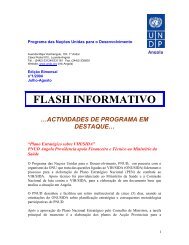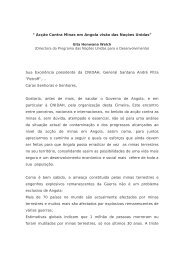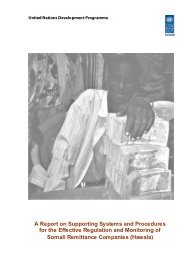CORRUPTION AND ANTI-CORRUPTION STRATEGIES ... - UNDP
CORRUPTION AND ANTI-CORRUPTION STRATEGIES ... - UNDP
CORRUPTION AND ANTI-CORRUPTION STRATEGIES ... - UNDP
Create successful ePaper yourself
Turn your PDF publications into a flip-book with our unique Google optimized e-Paper software.
country experiences discussed at the Paris<br />
workshop raised in one form or another the<br />
issue of political or managerial will: did the<br />
political leadership have the sustained commitment<br />
to anti-corruption reform or was it engaged in<br />
a merely 'cosmetic' exercise? In Hong Kong,<br />
exceptionally high political commitment, popular<br />
support, good organisation and a coherent strategy<br />
has yielded results, yet there are questions<br />
regarding the sustainability and transferability<br />
of such an approach. Botswana's case, with an<br />
equivalent vehicle for anti-corruption work,<br />
Diversity and the Search for Public Integrity<br />
The issue of the diversity of corruption is<br />
important. There are differing causes and<br />
consequences of corruption. The diverse<br />
outcomes of corruption and the associated<br />
scandal have significance in terms of both the<br />
short-term costs and the alleged longer-term<br />
developmental benefits. In some societies, as<br />
in East Asia, corruption may be extensive (if<br />
“isolated” within a distinct political sphere) but<br />
does not seem to be a barrier to rapid economic<br />
growth, whereas corruption is an integral part<br />
of the economic stagnation and decline of<br />
sub-Saharan Africa and has had damaging<br />
effects in Latin America (Diamond, 1987;<br />
Kpundeh, 1995; Little and Posada-Carbo,<br />
1996; World Bank, 1994; World Bank, 1997;<br />
Saba and Manzetti, 1996). Similarly, changes in<br />
policy at state, sub-state and micro-level, have<br />
created in previous decades, and continue to<br />
create, new incentives and opportunities in<br />
levels, patterns and prevalence of corruption.<br />
Thus the Chinese government's “immediate<br />
concern over the stagnant economy and<br />
therefore the necessity of revitalising society”<br />
as it has “relaxed its control over resource<br />
allocation, given great autonomy to local<br />
authorities to direct investment and decentralised<br />
its managerial power over enterprises”<br />
in the economic sector led not only to the<br />
revival of old patron-client networks but also<br />
staffed by some overseas officers, does suggest<br />
that there may be evidence that it has a role<br />
elsewhere, but its success will need to be<br />
gauged not only by the effectiveness of the<br />
judicial system but also through continuing<br />
political support as senior figures in political<br />
and public life are investigated. Tanzania's<br />
recent anti-corruption effort, with its inquiry<br />
process, needs to be turned into a sustained<br />
political and institutional commitment. The case<br />
of Ecuador clearly illustrates the outcomes of the<br />
political turmoil that gross corruption can cause.<br />
new patterns of corruption (Gong, 1993,<br />
pp. 317, 323-4).<br />
Furthermore, the diversity of corruption –<br />
and the perspectives and approaches of those<br />
reporting and analysing it – has had an impact<br />
on attempts at reducing or minimising the<br />
effects of corruption through anti-corruption<br />
strategies. Often the strategy proposed is based<br />
upon a distinct viewpoint concerning the<br />
causes and character of corruption. There have<br />
probably been three distinct approaches to<br />
contemporary corruption and anti-corruption<br />
strategies: economic analyses; mass public<br />
opinion, or civic culture, perspectives; and<br />
institutional viewpoints. Economic analyses<br />
prioritise the “principal-agent” relationship to<br />
identify corruption and anti-corruption strategies<br />
while mass public opinion or civic culture<br />
perspectives examine the social or cultural<br />
context of corruption and suggest, as a result,<br />
mass attitudinal change or civic awareness<br />
anti-corruption strategies. The institutional<br />
viewpoint looks either to strengthening<br />
institutions, such as the auditor-general or<br />
anti-corruption agency functions, or controls<br />
and procedures within institutions, such as<br />
codes and register of interests, to delineate the<br />
expectations of politicians and public officials.<br />
Thus Klitgaard's strategy is based upon<br />
<strong>CORRUPTION</strong>& INTEGRITY IMPROVEMENT INITIATIVES IN DEVELOPING COUNTRIES<br />
5 5







